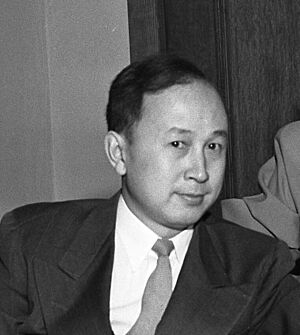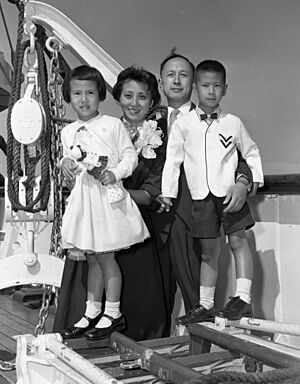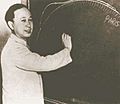Qian Xuesen facts for kids
Quick facts for kids
Qian Xuesen
|
|||||||||||
|---|---|---|---|---|---|---|---|---|---|---|---|

Qian in 1950
|
|||||||||||
| Born | 11 December 1911 |
||||||||||
| Died | 31 October 2009 (aged 97) |
||||||||||
| Nationality | Chinese | ||||||||||
| Alma mater |
|
||||||||||
| Known for |
|
||||||||||
| Spouse(s) |
Jiang Ying
(m. 1947) |
||||||||||
| Children | Qian Yonggang Qian Yungjen |
||||||||||
| Awards |
|
||||||||||
| Scientific career | |||||||||||
| Fields |
|
||||||||||
| Institutions |
|
||||||||||
| Theses |
|
||||||||||
| Doctoral advisor | Theodore von Kármán | ||||||||||
| Doctoral students |
|
||||||||||
| Chinese name | |||||||||||
| Traditional Chinese | 錢學森 | ||||||||||
| Simplified Chinese | 钱学森 | ||||||||||
|
|||||||||||
| Signature | |||||||||||
 |
|||||||||||
Qian Xuesen (Chinese: 钱学森; 11 December 1911 – 31 October 2009), also known as Hsue-shen Tsien, was a brilliant Chinese scientist. He was an expert in aerospace engineering and cybernetics. He made huge contributions to how rockets fly and how things move through the air. In America, he was known as a top expert in rockets and high-speed flight.
Qian Xuesen helped start the Jet Propulsion Laboratory (JPL) in the United States. This lab is now famous for building spacecraft for NASA. Later, he became known as the "Father of Chinese Rocketry" for his work in China. He helped China develop its own space program and defense technology.
Contents
Early Life and Education
Qian Xuesen was born in Shanghai, China, in 1911. His parents were Qian Junfu and Zhang Lanjuan. He went to National Chiao Tung University and earned a degree in mechanical engineering in 1934.
In 1935, Qian traveled to the United States to continue his studies. He went to the Massachusetts Institute of Technology (MIT). There, he earned a master's degree in aeronautical engineering in 1936.
While at MIT, he was known as Hsue-Shen Tsien. He learned a lot from the American way of teaching engineering, which focused on hands-on experiments. This was different from the more theoretical approach common in China at the time.
After MIT, he joined Theodore von Kármán's group at the California Institute of Technology (Caltech) in 1936. Von Kármán was a very important scientist who became Qian's mentor. Qian earned his doctorate in aeronautics and mathematics from Caltech in 1939.
Qian and his fellow students at Caltech became very interested in rockets. They did many experiments related to rockets. Their work was sometimes dangerous, and they were even nicknamed the "Suicide Squad" by others at the university.
Working in the United States
In 1943, Qian and his group wrote the first document that used the name Jet Propulsion Laboratory. This lab is now a key part of NASA. During World War II, Qian and other scientists helped develop important missiles for the United States.
In 1945, Qian, who was a colonel in the US Army, went to Germany. His job was to study German laboratories and talk to German scientists, including Wernher von Braun. He helped recruit these scientists for America's missile program.
His mentor, von Kármán, said that Qian was a "genius" whose work greatly helped advances in high-speed flight and jet engines. Qian also worked on designing a space plane that would later inspire the X-20 Dyna-Soar, a project that was a step towards the American Space Shuttle.
Qian married Jiang Ying, a famous opera singer, in 1947 in Shanghai. They had two children, a son named Qian Yonggang and a daughter named Qian Yongzhen.
After his wedding, Qian returned to America to teach at MIT. In 1949, he became a professor at Caltech and the first director of the Daniel and Florence Guggenheim Jet Propulsion Center there.
A Difficult Time
In the 1950s, during a time when the US government was worried about people with communist ideas, Qian Xuesen was accused of having such sympathies. In 1950, his security clearance was taken away. This happened even though his colleagues protested and there was no real proof against him.
Qian decided he wanted to return to China. However, the US government stopped him from leaving. For five years, he and his family were kept under a kind of house arrest. They were watched by the government. The goal was to make sure his scientific knowledge would become outdated.
After five years, in 1955, Qian was allowed to leave the United States. This was part of an exchange for American pilots who had been captured during the Korean War. He left the US in September 1955 and arrived in mainland China through Hong Kong.
A US official, Dan A. Kimball, who had tried to keep Qian in the US, later said, "It was the stupidest thing this country ever did. He was no more a communist than I was, and we forced him to go."
Return to China
When Qian Xuesen returned to China, he started a very successful career in rocket science. He became a key leader in China's missile program. He helped develop the Dongfeng ballistic missiles and the Long March space rockets.
He also played a big part in building China's defense industry and its higher education system. He helped create the People's Liberation Army Rocket Force and a major technology university. Because of his work, he became known as the "Father of Chinese Rocketry." He is also seen as one of the founding fathers of the "Two Bombs, One Satellite" program, which was China's effort to develop nuclear weapons and space technology.
In 1957, Qian was chosen as an academician of the Chinese Academy of Sciences. This is a very high honor for scientists in China. He also held important political positions, serving as a Vice Chairman of the National Committee of the Chinese People's Political Consultative Conference.
Qian was also involved in setting up the University of Science and Technology of China (USTC) in 1958. He led the Department of Modern Mechanics at the university for many years.
Beyond rockets, Qian worked in many other areas of science. He helped create new ways of thinking about complex systems. He also supported the scientific study of traditional Chinese medicine and qigong.
Later Life and Legacy
Qian Xuesen retired in 1991 and lived a quiet life in Beijing. He generally avoided speaking to people from Western countries.
In 1979, Caltech, his former university, gave him its Distinguished Alumni Award for his achievements. Qian received this award and brought it home. Caltech also offered to return his research papers to him.
Qian was invited to visit the US after relations between the two countries improved. However, he refused the invitation. He wanted a formal apology for his detention. Despite this, he still had warm feelings for the American people. He even approved of his children, who were US citizens by birth, returning to the US for their studies.
China launched its first manned space program in 1992. Qian's research was very important for the Long March rocket. This rocket successfully launched the Shenzhou 5 mission in October 2003, which was China's first manned space flight. Qian, who was elderly and in the hospital, watched this historic event on television.
In 2005, China's Premier Wen Jiabao visited Qian. During this visit, Qian asked a famous question: "So many students have been educated in these years. None of them is comparable with those masters educated during the period of the RoC in terms of academic achievements. Why cannot our universities educate outstanding talent?" This question, known as "Qian Xuesen's Question," led to many discussions in China about education and how to encourage new ideas.
In 2008, Aviation Week & Space Technology named Qian their Person of the Year. This award is given to the person who had the biggest impact on aviation that year. China Central Television also named him one of the most inspiring people in China.
Qian Xuesen passed away on October 31, 2009, in Beijing, at the age of 97.
After his retirement, Qian received many honors in China. He was called "the People's Scientist" and a "National Hero." Many books were written about his life, praising his scientific achievements and his contributions to China. He became a role model for many young Chinese students.
A Chinese film about his life, Hsue-shen Tsien, was released in 2011 and 2012.
Images for kids
-
Left to right: Ludwig Prandtl, Qian Xuesen, Theodore von Kármán. Prandtl served Germany during World War II; von Kármán and Qian served the United States; after 1955, Qian served China. Qian's overseas cap displays his temporary United States Army rank of colonel. Prandtl was von Kármán's doctoral adviser; von Kármán, in turn, was Qian's.
See also
- Chien-Shiung Wu
- Ye Qisun
- Guo Yonghuai
- Hsue-Chu Tsien
- People's Liberation Army Rocket Force
- Chinese space program
- Chinese nuclear program
- Project 596
- Test No. 6
- China Aerospace Science and Technology Corporation (formerly known as the Fifth Academy of the Ministry of Defense)







